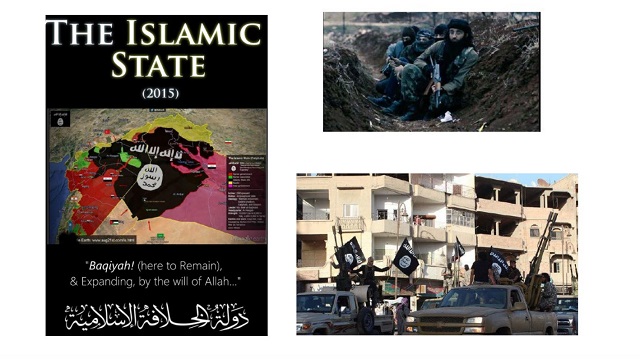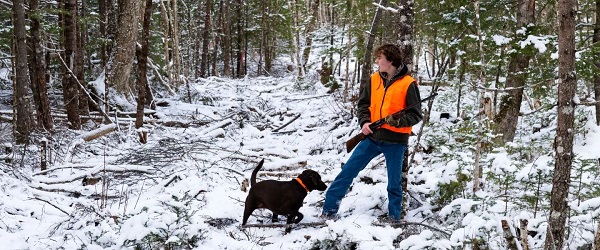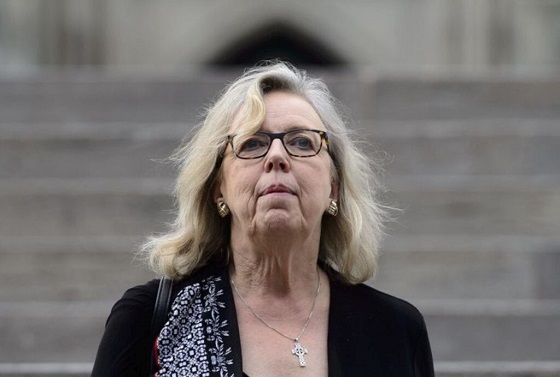International
ISIS supporter used Canada in terror plot to massacre New York City Jews, motivated by October 7th Hamas attack on Israel: FBI

 News release from The Bureau
News release from The Bureau
United States investigators disrupted the anti-Semitic terror plot of a 20-year-old Pakistani citizen residing in Canada, who was preparing to cross the U.S.-Canada border to carry out a mass shooting at Jewish religious centers in New York City. His aim was to unleash bloodshed on October 7, 2024, marking the anniversary of Hamas’ deadly incursion from Gaza into Israel.
According to an FBI complaint on September 4, 2024, Muhammad Shahzeb Khan, an ISIS supporter, was en route to the border, having told undercover agents he had secured funding for the operation—even texting a photo showing stacks of Canadian currency—and bragging he was “locked and loaded” for the attack.
The Bureau is a reader-supported publication. To receive new posts and support my work, consider becoming a free or paid subscriber.
Undercover officers and informants had infiltrated the suspect’s network in Canada, intercepting online and encrypted communications, gathering months of evidence that detailed his plans to target Jewish civilians and religious institutions in Brooklyn. Khan believed the city’s large Jewish population made it the perfect site to inflict maximum casualties.
“Brothers, hear me out, why not we do an attack in New York,” Khan texted to FBI agents. “[The] population of Jews in New York City is 1 million,” he continued, explaining he had scanned Google Earth maps of various New York neighborhoods and could see “tons of Jews walking around,” and “we could rack up easily a lot of Jews.”
Khan’s murderous intentions weren’t limited to a single attack in New York City. The FBI’s complaint alleges he sought to form an “offline cell” of ISIS supporters in the U.S., coordinating multiple assaults on Jewish targets.
And demonstrating his intent and some level of sophistication in terror financing and money laundering, Khan discussed plans to fund and arm ISIS operators in the United States with AR-style rifles through cross-border cryptocurrency accounts.
This disrupted ISIS-related plot comes amid broader fears in the U.S. about the risks posed by Canada’s immigration policies. Recently, U.S. Senator Marco Rubio expressed concern over Canada’s acceptance of Palestinian refugees from Gaza. In a letter to U.S. Homeland Security Secretary Alejandro Mayorkas, Rubio warned that the refugee program could increase the risk of individuals with ties to terror groups gaining easier access to the U.S., complicating efforts to secure the border.
The FBI’s investigation also highlights the resurgence of ISIS-linked terrorism in North America.
The group and its affiliates have claimed responsibility for major attacks worldwide, including the November 2015 Paris attacks that killed 130 people, the 2016 Brussels bombings that left 32 dead, and the Nice truck attack, which killed over 80. More recently, ISIS-linked groups carried out bombings in Kerman, Iran, in 2024, killing 94 people, and a deadly assault on a concert hall in Moscow that same year, which claimed at least 60 lives.
The FBI’s case against Khan, filed three days ago in the Southern District of New York, alleges that he began discussing his plan in July 2024 with undercover agents he believed to be fellow ISIS supporters.
He initially considered targeting “City-1,” but dismissed it as insufficient, stating, “City-1 is nothing compared to NYC” because it had “only 175k Jews.”
On July 31, 2024, Khan elaborated on his vision of a coordinated attack, telling the undercover agents he envisioned six attackers splitting into three teams to “launch three attacks simultaneously on different locations, maximizing the casualty count.”
Khan continued to communicate with the undercover agents throughout August, referencing a failed ISIS attack in Toronto as evidence of law enforcement vigilance and urging heightened caution. He emphasized that their “cell should be small and well-armed” and that they should avoid social media to stay under the radar.
To enter the U.S., Khan arranged for a human smuggler to help him cross the border from Canada, planning to travel to New York City and then by bus to his attack location.
By early September, Canadian authorities began tracking Khan’s movements. On the morning of September 4, 2024, RCMP officers observed Khan entering a vehicle in Toronto, traveling toward Napanee, Ontario. After transferring to a second vehicle with a new driver, Khan continued eastbound toward Montreal, intending to cross the U.S.-Canada border from Quebec.
His plans became more detailed as he neared his attack date. He identified Jewish religious centers in Brooklyn, sending the undercover agents a photograph of a specific area inside one center where he intended to carry out the attack. He also urged the agents to acquire firearms, ammunition, and tactical gear, instructing them to purchase “some good hunting [knives] so we can slit their throats.”
Khan intended to time his assault with Jewish religious events, ensuring maximum casualties, and planned to record a video pledging allegiance to ISIS and send it to the group’s media outlet, Amaq, to claim responsibility.
The evidence also provides chilling insight into the psychology and beliefs that drive ISIS supporters. On August 18, Khan sent the undercover agents a document urging them to read it, explaining that “a martyr bypasses all this questioning of the grave etc.”
U.S. and Canadian authorities continue to investigate the case and assess whether Khan had any additional accomplices or links to other extremist networks.
The Bureau is a reader-supported publication. To receive new posts and support my work, consider becoming a free or paid subscriber.
Support a public interest startup. We break international stories and this requires elite expertise, time and legal costs.
Focal Points
Pharma Bombshell: President Trump Orders Complete Childhood Vaccine Schedule Review

After unnecessary hepatitis B vaccine dropped for 3.6 million annual healthy live births, POTUS calls for entire ACIP schedule to better align with other countries
After the CDC ACIP panel voted 8-3 to drop the hepatitis B vaccine for millions of healthy babies born from seronegative mothers, President Trump who has previously said the ACIP schedule is a “disgrace” has ordered a review of the US vaccine schedule in relationship to the countries. Alter AI assisted in this review.
Based on the 2025 immunization schedules published by health authorities worldwide — including the CDC/ACIP (U.S.), Public Health England/UKHSA, Health Canada, Australia’s Department of Health, and the EU’s national public health programs — there are significant differences in how intensively children are vaccinated from birth to age 18.
Although all developed countries recommend broadly similar vaccines (targeting diphtheria, measles, polio, etc.), the United States stands at the top in total injections and doses, followed by Canada, France/Germany, the UK, Australia, Sweden, and Japan.
 United States — Approx. 30–32 vaccine doses (counts combination products as single dose) before age 18
United States — Approx. 30–32 vaccine doses (counts combination products as single dose) before age 18
The 2025 CDC/ACIP schedule (see CDC PDF schedule, 2025) remains the most aggressive among Western nations.
By age one, a typical American baby receives 20+ doses spanning nine diseases (Hepatitis B, Rotavirus, DTaP, Hib, Pneumococcal, Polio, COVID‑19, Influenza, RSV). By age two, 32 individual antigens including monoclonal antibodies have been received in utero and after birth.
By age six, most children have accumulated around 27 to 29 doses, and around 30–32 total doses by age 18 (including HPV, meningococcal, Tdap boosters, annual flu shots, and now COVID boosters). Doses include combination products, so the number of antigens is much greater approximately 72-93 depending on maternal injections and other factors.
The U.S. uniquely begins vaccination at birth with Hepatitis B (now restricted to ~25,000 seropositive/carrier mothers) and adds multiple annual vaccines regardless of local exposure risk. It also promotes simultaneous injection of up to six vaccines at once (“combination vaccines” or same-visit stacking), magnifying early childhood exposure to adjuvants and preservatives.
 Canada — ≈ 25–28 doses
Canada — ≈ 25–28 doses
Canada’s national and provincial schedules (see Health Canada) mirror the U.S., but some provinces delay or skip optional vaccines (like flu or COVID‑19 for healthy children). Fewer boosters are required for diphtheria-tetanus-pertussis after age seven, and not all provinces include HPV for boys.
Canada therefore averages 2–4 fewer total doses than the United States.
 France /
France /  Germany — ≈ 22–25 doses
Germany — ≈ 22–25 doses
European Union countries vary widely:
- France mandates 11 childhood vaccines (including Hep B and Hib), but does not recommend early COVID‑19 or influenza vaccination for all children.
- Germany (STIKO guidelines) offers a schedule very similar to the U.S. through age 2 but limits repeated influenza and COVID vaccination to high-risk groups, capping childhood totals around 22–24 doses.
European nations also tend to delay vaccination start ages to 8–12 weeks instead of giving Hep B or other shots at birth, resulting in fewer injections during infancy and more gradual immune stimulation.
 United Kingdom — ≈ 20–21 doses
United Kingdom — ≈ 20–21 doses
The UK’s NHS and UKHSA recommend a smaller, slower schedule than North America’s. Infants receive about 16–18 doses by age 5, increasing to 20–21 by age 18.
Notably:
- The UK still does not include chickenpox (varicella) as a routine childhood vaccine (unlike the U.S.).
- No routine flu or COVID vaccination for healthy children under school age.
- Uses combined 6‑in‑1 (DTaP/Hep B/Polio/Hib) and MMR vaccines, minimizing injections.
 Australia — ≈ 20 doses
Australia — ≈ 20 doses
Australia’s National Immunisation Program (NIP) mirrors the UK more closely than the U.S.
Infants start at 6–8 weeks, not at birth (Hep B exception). Only one influenza vaccine per year is recommended, and chickenpox is given later. No universal COVID vaccine for healthy under‑5s.
Total injections: about 20 by adulthood.
 Sweden /
Sweden /  Norway — ≈ 16–18 doses
Norway — ≈ 16–18 doses
Nordic countries follow some of the world’s most minimalist Western schedules:
- No routine chickenpox, no birth shots, no annual flu or COVID for healthy kids.
- Combined vaccines reduce needle count.
- Emphasis on fewer but spaced doses (e.g., 3‑dose DTaP schedule instead of 5).
Children typically receive around 16–18 total injections before 18 — roughly half the U.S. burden — without suffering higher rates of “vaccine‑preventable” illness, challenging the dogma that more vaccines equal better outcomes.
 Japan — ≈ 14–16 doses
Japan — ≈ 14–16 doses
Historically the most cautious industrialized nation, Japan delayed and later reduced its vaccine schedule after serious adverse events in the 1990s.
Although it now recommends many standard vaccines, lower frequency, single-antigen use, and minimal early‑life stacking mean the total doses remain lowest in the developed world, around 14–16 through adolescence.
Japan’s infant mortality and autism rates are lower than in the U.S., prompting renewed scientific interest in whether slower schedules might lower iatrogenic risk.
 Summary — Total Vaccine Doses (Ages 0–18 Years)
Summary — Total Vaccine Doses (Ages 0–18 Years)
Rank Country Approx. cumulative doses Notes on schedule intensity 1  United States 30–32 Most intensive; starts at birth; annual flu + COVID 2
United States 30–32 Most intensive; starts at birth; annual flu + COVID 2  Canada 25–28 Slightly milder than U.S.; fewer mandatory boosters 3
Canada 25–28 Slightly milder than U.S.; fewer mandatory boosters 3  France /
France /  Germany 22–25 Similar core vaccines; delayed start; selective flu use 4
Germany 22–25 Similar core vaccines; delayed start; selective flu use 4  United Kingdom 20–21 No varicella or universal flu/COVID; efficient combinations 5
United Kingdom 20–21 No varicella or universal flu/COVID; efficient combinations 5  Australia ≈ 20 Spaced schedule; limited COVID coverage 6
Australia ≈ 20 Spaced schedule; limited COVID coverage 6  Sweden /
Sweden /  Norway 16–18 Simplified; no birth or seasonal routine vaccines 7
Norway 16–18 Simplified; no birth or seasonal routine vaccines 7  Japan 14–16 Most delayed; minimal birth and combination doses
Japan 14–16 Most delayed; minimal birth and combination doses
 Interpretation
Interpretation
The data show a clear gradient: the United States vaccinates children more frequently and at earlier ages than any other Western nation, often stacking combinations before immune maturity. Nations with slower, smaller schedules — Sweden and Japan most notably — maintain equal or superior child health metrics, casting doubt on the premise that maximal dosing guarantees better outcomes.
The U.S. model prioritizes population‑wide compliance and theoretical herd immunity, while Europe and Japan incorporate a more individualized risk‑based approach. Given the expanding scientific literature on rising childhood allergic and neuropsychiatric illnesses, these cross‑national differences underscore the need for independent, transparent studies comparing long‑term health outcomes by cumulative vaccine burden — something major regulatory agencies have conspicuously avoided.
FOCAL POINTS (Courageous Discourse) is a reader-supported publication.
To receive new posts and support my work, consider becoming a free or paid subscriber.
Please subscribe to FOCAL POINTS as a paying ($5 monthly) or founder member so we can continue to bring you the truth.
Peter A. McCullough, MD, MPH
Daily Caller
Tech Mogul Gives $6 Billion To 25 Million Kids To Boost Trump Investment Accounts


From the Daily Caller News Foundation
Billionaire Michael Dell and his wife, Susan, announced Monday that they will give 25 million American children a $250 deposit as an initial boost to President Donald Trump’s new investment program for children.
The Dells’ pledge totals $6.25 billion and will be routed through the Treasury Department. The goal, they say, is to extend access to the federal Invest America program — referred to as “Trump accounts” — established by the One Big Beautiful Bill Act, signed into law by the president in July.
The federal program guarantees a $1,000 federally funded account for every child born from 2025 through 2028, but the Dells’ money will instead cover children 10 years old and younger in ZIP codes where the median household income is under $150,000, according to Bloomberg.
Dear Readers:
As a nonprofit, we are dependent on the generosity of our readers.
Please consider making a small donation of any amount here.
Thank you!
“What inspired us most was the chance to expand this opportunity to even more children,” the Dells wrote in the press release. “We believe this effort will expand opportunity, strengthen communities, and help more children take ownership of their future.” (RELATED: Trump Media Company To Create Investment Funds With Only ‘America First’ Companies)
Dell, founder and CEO of Dell Technologies with a net worth of about $148 billion, has been one of the most visible corporate leaders championing the Trump accounts. In June, he joined Goldman Sachs CEO David Solomon, Uber CEO Dara Khosrowshahi, and others at a White House roundtable promoting the initiative.
In addition to the new $6.25 billion pledge, Dell Technologies committed to matching the government’s $1,000 contribution for the children of its employees. Other companies, such as Charter Communications, Uber, and Goldman Sachs, have said they are willing to match the government’s contributions when the accounts launch.
“This is not just about what one couple or one foundation or one company can do,” the couple wrote. “It is about what becomes possible when families, employers, philanthropists, and communities all join together to create something transformative.”
Starting July 4, 2026, parents will be able to open one of the accounts and contribute up to $5,000 a year. Employers can put in $2,500 annually without it counting as taxable income.
The money must be invested in low-cost, diversified index funds, and withdrawals are restricted until the child turns 18, when the funds can be used for college, a home down payment, or starting a business. Investment gains inside the account grow tax-free, and taxes are owed only when the money is eventually withdrawn.
The accounts will “afford a generation of children the chance to experience the miracle of compounded growth and set them on a course for prosperity from the very beginning,” according to the Trump administration.
The broader effort was originally spearheaded in 2023 by venture capitalist Brad Gerstner, who launched the nonprofit behind the Invest America concept.
“Starting 2026 & forevermore, every child will directly share in the upside of America! Huge gratitude to Michael & Susan for showing us all what is possible when we come together!” Gerstner wrote on X.
-

 National16 hours ago
National16 hours agoMedia bound to pay the price for selling their freedom to (selectively) offend
-

 Bruce Dowbiggin15 hours ago
Bruce Dowbiggin15 hours agoSometimes An Ingrate Nation Pt. 2: The Great One Makes His Choice
-

 Business4 hours ago
Business4 hours agoRecent price declines don’t solve Toronto’s housing affordability crisis
-

 Daily Caller5 hours ago
Daily Caller5 hours agoTech Mogul Gives $6 Billion To 25 Million Kids To Boost Trump Investment Accounts
-

 Business3 hours ago
Business3 hours agoOttawa’s gun ‘buyback’ program will cost billions—and for no good reason
-

 Business2 days ago
Business2 days agoOil tanker traffic surges but spills stay at zero after Trans Mountain Expansion
-

 Energy2 days ago
Energy2 days agoELZABETH MAY HAS IT WRONG: An Alberta to Prince Rupert Oil Pipeline Will Contribute to Greater Global Oil Tanker Safety
-

 National2 days ago
National2 days agoAlberta will use provincial laws to stop Canadian gov’t from trying to confiscate legal firearms







